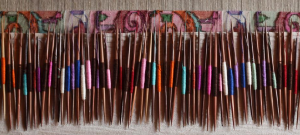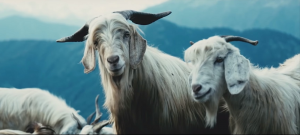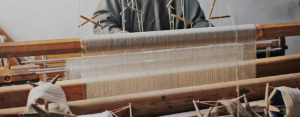Talk about the most demanded luxurious accessory in the world and Pashmina name comes up. The word Cashmere Pashmina sounds like the royalty in itself. A timeless luxury that has been a symbol of sophistication and class for the elite since the times immemorial. Kashmiri Pashmina was set into fashion when Empress Josephine wore a Kani Pashmina Shawl which was gifted to her by her husband Napoleon. Since then it has been a choice of opulence for many people around the globe. From Bollywood celebrities to Hollywood to royals of British, Pashmina has made its place in the closet of all. So what makes this luxury the quintessential it is today, let us try and get to know more about it.
About Pashmina:
The word Pashmina has been derived from the word “Pashm” which literally mean soft gold. Pashmina is the plushest and finest form of wool which is obtained from a goat named Chanthangi (Capra Hiracus). The goat is native to the mountains across Himalayan Ranges. To protect itself against the killing cold of 15000 ft, the goat develops the finest wool in the world and when spring comes, the same is shed. The goat rubs itself against the rocks leaving behind the fleece which is then collected and worthfully sold. Pashmina is made from the under fleece of Changthangi goat.
Around 70% of Pashmina comes from China, 20% from Mongolia and 10% of it comes from Kashmir but it is believed that the best of Pashmina comes from Kashmir. Westerners also discovered the fabric first in Kashmir only which is why they call it Cashmere. Since Kashmiri Pashmina tops the quality list, let us get to know more about it.
About Kashmiri Pashmina:
Pashmina was introduced to Kashmir by a Muslim Saint named Syed Mir Ali Hamdani in the 14th century. He along with his 700 craftsmen went to Ladakh where he found that Ladakhi goats produce the most plus wool in the world, impressed, he made socks out of it and gifted them to the then king of Kashmir, Sultan Kitabudin and suggested that they should start a Pashmina Weaving industry in the valley. This marked the beginning of Pashmina making in Kashmir and since then it has been one of the most cherished crafts and has been passed on from generation to generation.
On receiving the wool from Ladakh, it goes under many processes and finally evolves into a luxurious and timeless Accessory. The fibre is first dehaired and cleaned, after that spinning is done on a traditional wheel called Charkha, after Weaving follows and then dyeing and washing. The detailed process of Pashmina making involves around 33 artisans from start to end. The process is very labour intensive which is one of the reasons for the expensiveness of Pashmina. Kashmiri Pashm is considered to be the finest of all fibres with a range 12 – 13 μ (microns) and a fibre length of 55 to 60 mm. It is this finesse which lends it its rarity and earns it a special place in the world of luxury fashion.
Over a period of time, Kashmiri Pashmina has been facing some threats in terms of its quality because of the presence of duplicate and fake Pashmina in the market. Sellers claiming to sell the original Pashmina are actually selling the duplicate ones which is hitting the industry to a great extent. Now to combat the same, Kashmiri Pashmina was registered under the Geographical Indications (G.I) of Good Act of India on 09-12-2008. The registration is an acknowledgement of the fact that the handicraft is unique and is produced in a particular area with traditional knowledge and skills, special to the region. Kashmiri Pashmina G.I. mark labeled product has a covert (readable under UV light) and a visible unique code, which can be searched on www.kashmirpashmina.secure-ga.com to verify authenticity. Any Pashmina which is to get the mark has to fulfil the 3 prerequisites.
- It should be made of “Pashm” fibre which is obtained from the under fleece of Changthangi Goat and should be having a finesse of below 16 microns.
- It should be handspun on a traditional wheel called Charkha.
- Lastly, it should be woven on a handloom which is specific to it.
When all the 3 requirements are met, it is deemed to be an authentic and certified Pashmina. For any Pashmina buyer, it might be a good option to go for Certified Pashmina rather than any other type because of the guarantee of authenticity. `
Original Pashmina as per grassroot artisans can be used for over 100 years which undoubtedly make it a timeless luxury. Another matter of fact is that as per Pashmina artisans “Ring Test” is absolutely faux and does not in any way prove the authenticity of it. The best way to be sure of the authenticity is to buy a Certifies Pashmina which is hand spun and hand woven.
There is another type of Pashmina as well which is Machine Spun Hand Woven. The difference from the former lies in the spinning of the accessory. In Machine Spun Pashmina, to give it the strength to bear a machinery pressure, some nylon is added which is then removed but the negligible part of it remains. This negligible part is detected during testing because of which it does not acquire a mark. So to be on the safer side we would recommend a Certified Pashmina for that timeless glory.
To adorn your closet with this luxury, you may not know that there are actually many options to choose from. We have listed the various types of Pashmina you would consider from.
Types Of Pashmina to Choose From.
- Plain/Solid Pashmina: The most basic yet stylish type of Pashmina is the solid Pashmina. Solid shades for both men and women form the most elegant unisex statement. Solid Pashmina is generally the most demanded Pashmina, one because they go with any outfit and are a very minimalistic luxury, two they are priced less as compared to others.
- Sozni Embroidered Pashmina:
The second and the most exquisite type of Pashmina is the Sozni embroidered Pashmina. Sozni is a type of hand Kashmiri Embroidery which is done using a needle. A beautiful solid Pashmina is passed on to the Sozni Karigar who first traces the design on the shawl and then with the help of needle casts the intricate embroidery over the pattern. The embroidery patterns are generally inspired by nature. Jamawar, Jaalidaar, Shahpasand, Palladar and Doridaar designs are some of the most famous threaded designs. A sozni pashmina shawl may take from months to years in the making depending upon the amount of embroidery to be done. The art of Sozni along with the Pashmina base literally doubles the luxury quotient.
- Kani Pashmina:
Perhaps the most beautiful form of Pashmina is the Kani Pashmina. Kani Pashmina in Kashmir believed to have originated from a local village named Kani Hama. The Pashmina that comes from this village is registered under the G.I goods act as well. The bars of the Kani Pashmina were raised when Empress Josephine wore one Kashmiri Kani which was gifted to her by her husband Napoleon.
Kani Pashmina is woven using small wooden sticks which are known as Kanis. The Kani Pashmina costs generally start from 50000 INR, today when the markets are flooded with fake Pashminas, Kani has also got a threat, shawls which are mere a print of Kani are sold in the name of it. However to be sure just know that Kani Pashmina is never a print rather it is a woven accessory. Contemporary Pashmina:
Keeping up with the ever changing fashion and trends, Pashmina has evolved over a period of time as well. Modern designs are now being introduced in the industry to keep it in a race. Modernism yet rooted in traditions is what modern Pashmina is all about. From checks, stripes, blots to dual shades, this category has catered it all.
- Tilla Embroidery Pashmina:
Another type of Pashmina in the list for today is the Tilla Embroidered Pashmina. Tilla Embroidery is a traditional craft in Kashmir which involved embroidering using silver or golden threads. Now the embroidery is done using gold & silver plated metallic threads to make it more affordable. Till Pashmina makes for an important part in the Bridal trousseau.
- Towel Pashmina
The deluxe towel shawls are hand woven into warps and wefts and threads of Pashmina, popularly known as loops are manually picked from the shawl by master artisans with the help of tweezers. These loops make the classic wrap warmer than the regular Pashmina and perfect to drape on a totally gelid winter morning.
- G.I Certified Pashmina
A Certified Pashmina is a hand spun and hand woven cashmere luxury.
Certification of the shawls is done by a government recognised institute which authenticates the originality of Pashmina by providing a covert label (readable under UV light). The mark has a unique visible code as well which can be searched on www.kashmirpashmina.secure-ga.com to verify authenticity. Specifications for a Kashmiri Pashmina to quality for GI seal are:
- It should be made of 100% Pashmina Fiber having a fineness of below 16 microns and obtained from the under fleece of mountain goat “Capra Hircus”
- Handspun on the traditional wheel (Charkha)
- Woven by artisans traditionally and skilful developed unique handloom specific to it.
With all the many types of Pashminas available, there are a lot of options to choose your style from. So have you decided on your timeless luxury yet?



